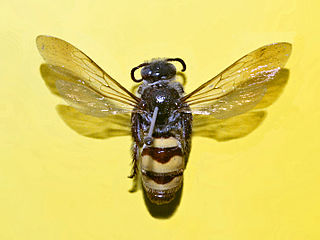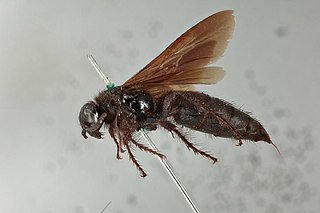
The Scoliidae, the scoliid wasps, are a family of wasps comprising about 560 species worldwide. They tend to be black, often marked with yellow or orange, and their wing tips are distinctively corrugated. Males are more slender and elongated than females, with significantly longer antennae, but the sexual dimorphism is not as apparent as in many of the Tiphiidae and Thynnidae.

The Narina trogon is a largely green and red, medium-sized, bird of the family Trogonidae. It is native to forests and woodlands of the Afrotropics. Though it is the most widespread and catholic in habitat choice of the three Apaloderma species, their numbers are locally depleted due to deforestation. Some populations are sedentary while others undertake regular movements.

Megascolia procer, the giant scoliid wasp, is a solitary wasp in the family Scoliidae found across Asia. It is one of the largest wasps in the world, with a wingspan of 11.6 cm (4.6 in).

Lissopimpla excelsa, commonly known as the orchid dupe wasp, is a wasp of the family Ichneumonidae native to Australia. Although also found in New Zealand, where it is known as the dusky-winged ichneumonid, it has probably been introduced there. However, another source states that it may be native to New Zealand.

Scolia hirta is a species of wasp in the subfamily Scoliinae of the family Scoliidae.

Scolia dubia, also known as the two-spotted scoliid wasp or a blue-winged scoliid wasp, is a species in the family Scoliidae.

Austroscolia soror is a species of scoliid wasp and a common insect found in eastern Australia. This is one of several Australian species collectively referred to as a blue flower wasp, black flower wasp, or blue hairy flower wasp.

Scolia is a genus of scoliid wasps in the subfamily Scoliinae. There are over 200 described species in Scolia.

Campsomeris is a Neotropical genus of the family Scoliidae, also known as the scoliid wasps. They are generally parasites of beetle larvae, most often of Scarabaeidae.

Dielis trifasciata, also known as the three-banded scoliid wasp, is a species in the family Scoliidae.

Dielis is a New World genus of the family Scoliidae, also known as the scoliid wasps, formerly treated as a subgenus within Campsomeris.

Pygodasis is a New World genus of wasps in the family Scoliidae, formerly treated as a subgenus within Campsomeris.

Xanthocampsomeris is a New World genus of the family Scoliidae, also known as the scoliid wasps, formerly treated as a subgenus within Campsomeris.

Scoliini is a cosmopolitan tribe of the family Scoliidae.

Austroscolia is a genus of wasps belonging to the family Scoliidae, subfamily Scoliinae. It was formerly classified as a subgenus of Scolia.

Campsomeriella thoracica is a species of scarab parasitoid wasp that has been recorded in the Middle East, Mediterranean, and Sub-Saharan Africa.

Dielis plumipes, the feather-legged scoliid wasp, is a species of scoliid wasp in the family Scoliidae.

Triscolia ardens is a species of wasp in the family Scoliidae. It is the sole member of its genus found in North America outside of Mexico.

Scolia carbonaria is a species of wasp in the family Scoliidae.

Dielis tolteca, the Toltec scoliid wasp, is a species of hymenopteran in the family Scoliidae. It is commonly found on plants in the genus Solidago.




















